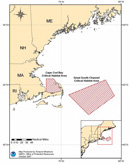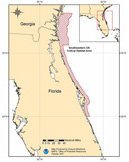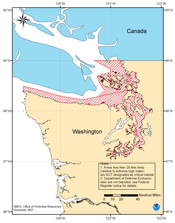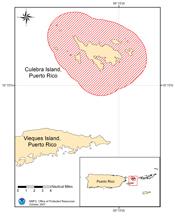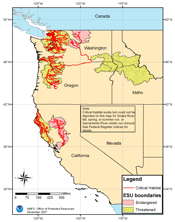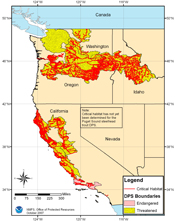Critical Habitat
Overview
The Endangered Species Act (ESA) requires the Federal government to designate "critical habitat" for any species it lists under the ESA. Critical habitat is defined as:
- Specific areas within the geographical area occupied by the species at the time of listing, if they contain physical or biological features essential to conservation, and those features may require special management considerations or protection; and
- Specific areas outside the geographical area occupied by the species if the agency determines that the area itself is essential for conservation.
Species & Critical Habitats
(All links below are PDF files.)
Please note that the critical habitat maps provided here are for illustrative purposes only. Textual descriptions of critical habitats, which are provided in the associated Federal Register notices (see below), are the definitive sources for determining critical habitat boundaries.
- Cook Inlet Beluga Whale Critical Habitat Designation Available for Public Comment Through May 14 [pdf]
Marine Mammals
| Map | Year | Federal Register |
|---|---|---|
| Hawaiian Monk Seal | 1988, 1986 |
53 FR 18988, 51 FR 16047 |
| Killer Whale (Southern Resident) | 2006 | 71 FR 69054 |
| North Atlantic Right Whale | 1994 | 59 FR 28793 |
| North Pacific Right Whale | 2008, 2006 |
73 FR 19000, 71 FR 38277 |
| Steller Sea Lion | 1993 | 58 FR 45269 |
Sea Turtles
| Map | Year | Federal Register |
|---|---|---|
| Green Turtle | 1998 | 63 FR 46693 |
| Hawksbill Turtle | 1998 | 63 FR 46693 |
| Leatherback Turtle | 1979 | 44 FR 17710 |
Marine and Anadromous Fishes
| Map | Year | Federal Register |
|---|---|---|
| Proposed Atlantic Salmon | 2008 | 73 FR 51747 |
| Chinook Salmon (multiple ESUs*) |
1993- 2005 |
various |
| Chum Salmon (multiple ESUs*) |
2005 | 70 FR 52630 |
| Coho Salmon (multiple ESUs*) |
1999- 2008 |
64 FR 24049 73 FR 7916 |
| Proposed Green Sturgeon | 2008 | 73 FR 52084 |
| Gulf Sturgeon | 2003 | 68 FR 13370 |
| Sockeye Salmon (multiple ESUs*) |
1993- 2005 |
various |
| Proposed Smalltooth Sawfish | 2008 | 73 FR 70290 |
| Steelhead Trout (multiple DPSs*) |
2005 | 70 FR 52630 |
*Under the ESA, "species" includes subspecies, or, for vertebrates only, "distinct population segments (DPSs)". Pacific salmon are listed as "evolutionarily significant units (ESUs)", which are essentially equivalent to DPSs for the purpose of the ESA.
Marine Plants & Invertebrates
| Map | Year | Federal Register |
|---|---|---|
| Elkhorn Coral | 2008 | 73 FR 72210 |
| Staghorn Coral | 2008 | 73 FR 72210 |
| Johnson's seagrass | 2000 | 65 FR 17786 |
Critical Habitat Designations
Critical habitat designations must be based on the best scientific information available, in an open public process, within specific timeframes.
A critical habitat designation does not set up a preserve or refuge. It applies only when Federal funding, permits, or projects are involved. Under Section 7 of the ESA, all Federal agencies must ensure that any actions they authorize, fund, or carry out are not likely to jeopardize the continued existence of a listed species, or destroy or adversely modify its designated critical habitat.
Critical habitat requirements do not apply to citizens engaged in activities on private land that do not involve a Federal agency.
Before designating critical habitat, careful consideration must be given to the economic impacts, impacts on national security, and other relevant impacts. The Secretary of Commerce may exclude an area from critical habitat if the benefits of exclusion outweigh the benefits of designation, unless excluding the area will result in the extinction of the species concerned.
More Info
Code of Federal Regulations: 50 CFR 226 - Designated Critical Habitat [pdf]
Geographic Information Systems (GIS) Data on Critical Habitat
